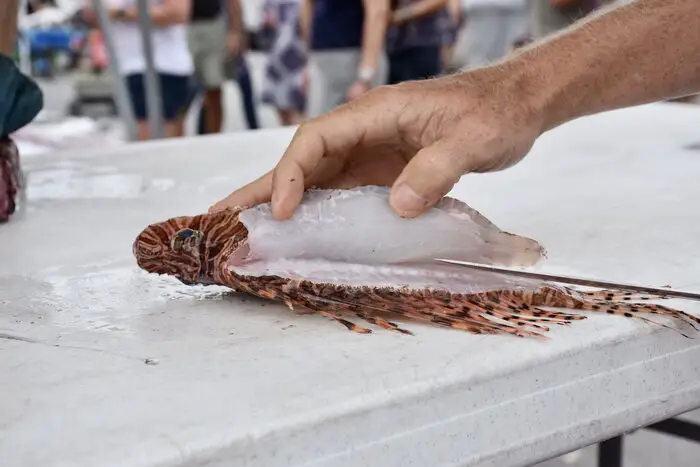Most people are familiar with Lionfish as ornamental aquarium fish, but many anglers and divers are noticing these fish in native waters off the Atlantic coast…
In fact, since the 1980s, the non-native Lionfish population has exploded, which is cause for concern.
So, how can we combat these non-native fish? Are they edible? And if so, are they any good to eat?
By the end of this article, I bet you’ll be planning your next lionfish meal night!
Table of Contents
- Are Lionfish Good To Eat?
- Are Lionfish Safe To Eat (Venomous Spines?)
- What Do Lionfish Taste Like?
- How To Catch Lionfish
- Where To Buy Lionfish To Eat
- How To Prepare Lionfish
- Best Ways To Cook Lionfish
- How Did Lionfish Get Into US Waters?
- Final Thoughts
Are Lionfish Good To Eat?
I’ll cut straight to the point, not only are Lionfish edible, they are fantastic to eat and taste delicious. They have white meat with a pinkish hue, very mild flavor, and medium texture.
They’re a very versatile fish and taste great when pan-fried, grilled, baked, or even in a fresh ceviche.
However, before you load the cooler with Lionfish, it’s important to know a few things about these popular aquarium pets, including where they come from and how to avoid their venomous spines.

Are Lionfish Safe To Eat (Venomous Spines?)
Lionfish are known for their venomous spines, which can cause pain, swelling, and other symptoms if they come into contact with human skin.
However, the venom is only dangerous if it enters the bloodstream (if it pokes you!), which is unlikely to happen when consuming cooked and dead lionfish.
It is important to note that lionfish are not poisonous to eat, as their venom is protein-based and is broken down by heat.
The venomous spines should be removed before cooking, and the fish should be cooked to an internal temperature of 145°F to kill any potential bacteria or parasites.
In summary, lionfish are safe to eat as long as they are properly prepared and cooked. While their venomous spines may be a concern, you just have to be cautious when handling and processing the fish (which I explain in more detail below).
What Do Lionfish Taste Like?
The white flaky flesh of Lionfish is very similar to black sea bass or flounder. It has a very delicate texture, but it’s not mushy. The flavor is mild, and when prepared fresh it can be fantastic!
In the past 10 years or so, restaurants and fish markets have caught on to the desirable taste of Lionfish. It’s common on menus throughout the Caribbean and southern Atlantic.
How To Catch Lionfish
Catching Lionfish on conventional hook and line is actually quite difficult. These slow-moving fish often hang close to the bottom, in and out of structures (like reefs and rocks) and seldom hit lures or live bait.
Your best bet to catch a lionfish is to use something like live shrimp, or small baitfish on a 1/0 circle hook. Drop your bait down and get it as close to the lionfish as possible, and wait for a strike.
The problem is that other fish like snapper, grunts, and chubs will often get to your bait first. But, with enough persistence it’s possible!
Spearing Lionfish
If you really want to fill the cooler with lionfish, grab your mask, snorkel, and spear gun.
In fact, using a spear gun, pole spear or Hawaiian sling is the most popular and most efficient way to harvest lionfish.
Because they are so slow and often sit motionless in the water, they are prime and easy targets for spearing. Throughout the Bahamas and off the coast of Florida, this is common practice.
And since you can find Lionfish as shallow as 6 feet deep, you don’t even need diving gear. Free-diving and spearing Lionfish is fun, efficient, and a great way to come home with a ton of meat!
Just be sure to wear a pair of heavy-duty gloves!

Where To Buy Lionfish To Eat
In the past decade or so, Lionfish have started to appear in fish markets and seafood houses along the Atlantic Coast.
I have seen these non-native fish at popular supermarkets like Publix, and local family-owned fish markets.
You can sometimes find them online, but your best bet is to call around to some of the local commercial fish houses and they’ll point you in the right direction.
See Also: Are Oyster Toadfish Good To Eat? You Might Be Surprised!
How To Prepare Lionfish
Lionfish can be cooked in a variety of ways, including grilling, frying, and baking. However, before cooking, it is important to properly clean and fillet the fish to remove spines.
Watch Out For The Spines!
Lionfish have venomous spines that can cause pain, swelling, and even temporary paralysis if not handled properly. To avoid injury, it is recommended to wear gloves and use a pair of scissors or clippers to remove the spines.
To clean and fillet the lionfish, follow these steps:
- Rinse the fish under cold water and pat dry with a paper towel.
- Cut off the head and tail of the fish.
- Use scissors or clippers to remove the spines along the top and bottom of the fish.
- Cut along the belly of the fish and remove the internal organs.
- Rinse the fish again and pat dry.
- Use a sharp knife to cut along the backbone of the fish and remove the fillets.
- Cut the fillets into desired portions, or scale and cook whole.
Best Ways To Cook Lionfish
Lionfish is a versatile fish that can be cooked in many different ways. Here are some of the best ways to cook lionfish:
Ceviche
Ceviche is a popular way to prepare lionfish. It involves marinating the fish in citrus juice, which “cooks” the fish without heat.
Lionfish ceviche is typically made with lime juice, red onion, cilantro, and diced tomatoes. It can be served as an appetizer or a light meal.
Butter-Pan Fry
For a simple and delicious way to cook lionfish, try butter-pan frying. Heat a pan over medium-high heat and add a tablespoon of butter.
Once the butter has melted, add the lionfish fillets and cook for 2-3 minutes per side, or until the fish is golden brown and cooked through. Serve with a squeeze of fresh lime juice.

Grilled
Grilling lionfish is another great option. Brush the fillets with olive oil and season with salt and pepper. Heat the grill to medium-high heat and grill the fish for 3-4 minutes per side, or until it is cooked through.
Serve with a side of grilled vegetables for a healthy and delicious meal.
Baked
Baking lionfish is a simple and healthy way to cook the fish. Preheat the oven to 375°F and place the lionfish fillets in a baking dish. Brush the fillets with olive oil and season with salt and pepper.
Bake for 10-12 minutes, or until the fish is cooked through. Serve with a side of roasted vegetables for a complete meal.
Overall, lionfish is a delicious and healthy seafood option that can be cooked in many different ways. With these recipes and techniques, you can enjoy this tasty fish in a variety of dishes.
How Did Lionfish Get Into US Waters?
Lionfish are native to the Indo-Pacific region, including the South Pacific and Indian Ocean. However, they were first discovered in US waters off the coast of Florida in the mid-1980s.
The exact cause of their introduction to these waters is unclear, but it is believed that they were released by aquarium owners who no longer wanted to care for them or by boats traveling between the Caribbean and Florida.
Lionfish Hunting and Conservation Efforts
Lionfish are considered an invasive species in the Atlantic and Caribbean waters, as they have no natural predators and reproduce rapidly, causing harm to native fish and coral reefs.
To address this issue, lionfish hunting has become a popular activity in these areas. Divers use spears or nets to catch the fish, which are then used for food or sold to restaurants.

Conservation efforts have also been implemented to control the lionfish population and protect native species and ecosystems.
For example, in Florida, there is an annual Lionfish Removal and Awareness Day, where the Florida Fish and Wildlife Conservation Commission hosts statewide events and tournaments to encourage the harvest of Lionfish.
These efforts include promoting sustainable fishing practices, encouraging the consumption of lionfish as a food source, and educating the public about the importance of maintaining a healthy marine environment.
In conclusion, while lionfish may be a delicious food source, it is important to consider the impact of their introduction to non-native waters.
Efforts to control their population and protect native species and ecosystems are ongoing, and it is important for individuals to be aware of their role in maintaining a sustainable environment.
Final Thoughts
So, not only are Lionfish perfectly edible, they are actually very good to eat. And since harvest is highly encouraged, that means plenty of opportunity to fill the freezer.
Grab your pole spear, and have some fun. Just be sure to mind those venomous spines…enjoy!
You May Also Like: Are Black Drum Good To Eat or Full of Worms?

Growing up in Florida, I’ve been surrounded by saltwater my entire life…and I love sharing my passion with others.
To learn more about why I started Saltwater Mecca, visit the ABOUT page.
Thank you for reading this article. Browse around & have some fun!